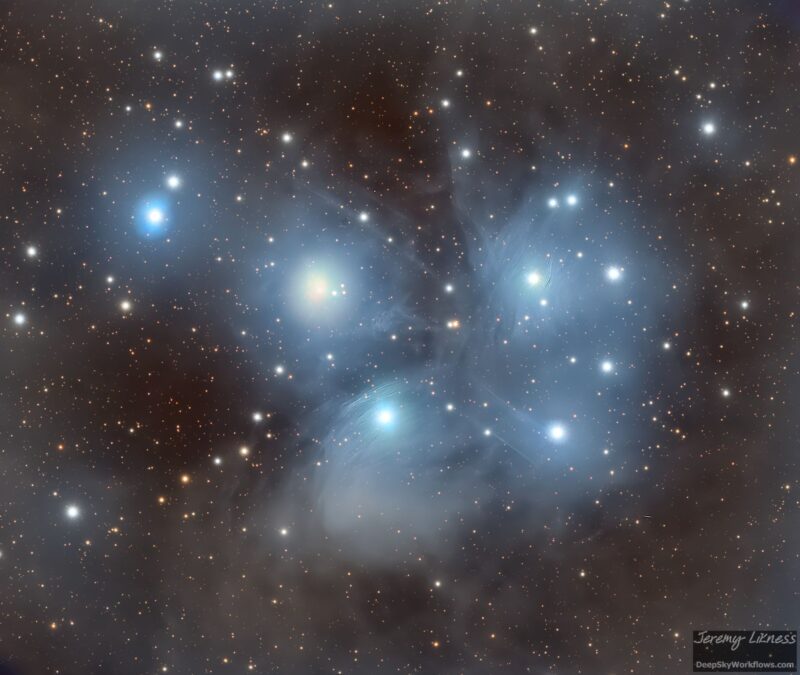
Open star clusters
Open star clusters are young, loosely bound gatherings of stars. The stars in these clusters were born together. They’re still sometimes moving within the nebula, or cosmic cloud, of their creation. They’re occasionally called galactic clusters. Scientists have discovered more than 1,100 open clusters around us in space. They may contain a handful of stars or thousands of stars. Most likely won’t survive more than several orbits around our galaxy’s center before being disrupted and dispersed. You can see many open star clusters with the eye alone! Or you can aim binoculars or telescopes their way …
Pleiades is a gem among open star clusters
The Pleiades cluster (M45) is a wonderful open cluster in the constellation Taurus the Bull. A favorite observing target, the Pleiades stands out to the eye alone as a fuzzy patch that resembles a tiny dipper. About six stars are visible with the unaided eye. Through binoculars, the view explodes into dozens of stars.
The Pleiades – aka the Seven Sisters – may have dimmed enough since its naming, because only six stars are now readily visible. The word Pleiades translates to Subaru in Japanese, and you might recognize the grouping of six stars from the car-maker’s logo. The stars in the Pleiades were born together about 100 million years ago. And the open cluster itself lies about 440 light-years away.
What about globular star clusters?
By the way, open star clusters are not to be confused with tightly bound globular star clusters. Globular clusters are ancient and far away, orbiting in the halo of the Milky Way. In fact, globular clusters formed about 13 billion years, when the Milky Way was forming. In contrast, open clusters are typically only millions of years old.
One of the best-known globular clusters seen from the Northern Hemisphere is the Great Cluster in Hercules (M13). It’s about 25,000 light-years away. Contrast the M13’s large distance to that of the relatively nearby Pleiades (444 light-years).
Read more: The Pleiades or 7 Sisters
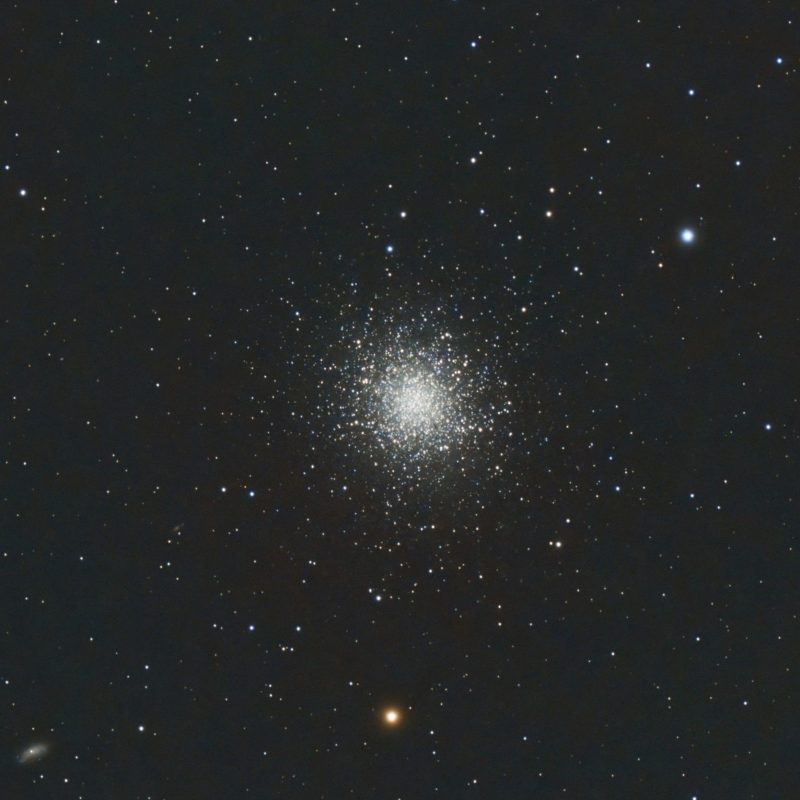
Distance to open star clusters makes a difference
The distance to a star cluster will affect its appearance to us on Earth. Open star clusters are recognizable as a concentration of stars in one area of the sky. These conglomerations of light – such as the Pleiades or the Wild Duck Cluster (M11) – are obvious to telescope and binocular users. Many are obvious through binoculars when you are skimming along the Milky Way.
But what about star clusters that are closer to Earth?
Some Big Dipper stars are members of an open cluster
The familiar Big Dipper asterism is part of an open cluster. These stars are all about 80 light-years away and belong to a loosely assembled open star cluster known as the Ursa Major Moving Group. The Big Dipper is an example of a cluster that’s so close that it wasn’t immediately identifiable as a cluster. First, astronomers had to learn about the motions of stars in various parts of the sky. Then, they understood the Ursa Major Moving Group was an open cluster.
The Big Dipper, just like other open clusters, will grow apart as it ages. Alkaid and Dubhe, two stars in the Big Dipper, are not part of the Ursa Major Moving Group. Those two stars will stretch away from the rest and the dipper shape will become obscured, forming a new shape, just as many thousands of years ago the stars looked more like a kite with a long tail than its current dipper shape.
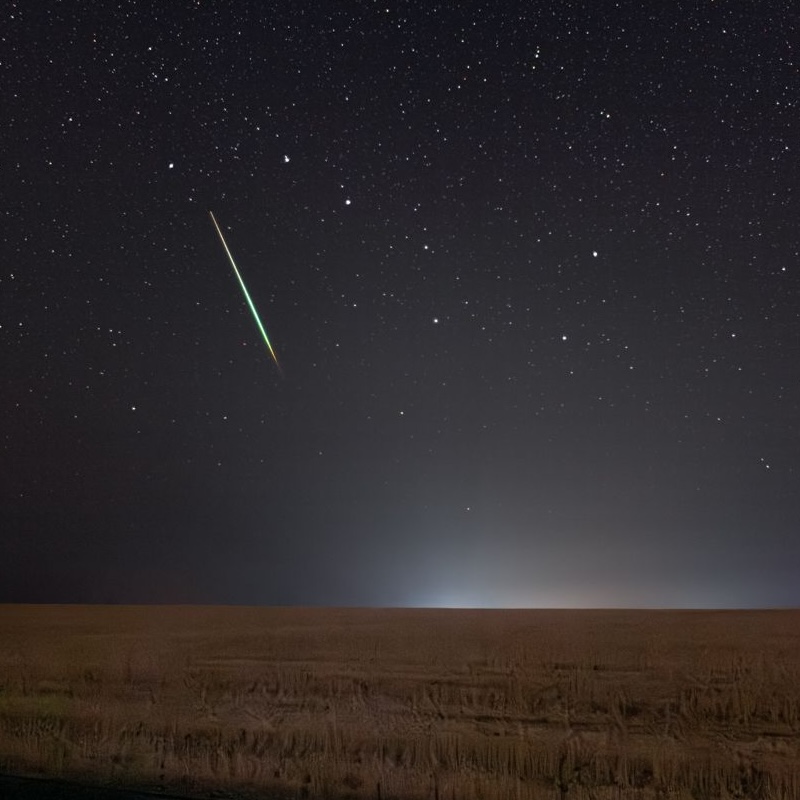
Watch how the Big Dipper changes over time
Hyades is another star cluster in Taurus
The V-shaped Hyades star cluster in the constellation Taurus the Bull is another excellent open cluster to target with the eye alone. The Hyades is so large you could not hope to capture the entire cluster within the field of view of binoculars or a telescope. Instead, binocular and telescope-users examine the cluster bit by bit.
The Hyades marks the head of Taurus the Bull. It is a large open star cluster in the shape of the letter V and is visible during northern winter (southern summer). This open star cluster is a group of 300 to 400 stars that lie about 151 light-years away from us, thus making it one of the nearest open clusters to Earth. With the unaided eye under moderately good seeing conditions, an observer should be able to see five stars that mark the two sides and juncture of the V.
The stars of Hyades
The five brightest stars in the Hyades are all red giants, but you’ll notice one shines much more brightly than the others. The brightest star in Hyades – and in the constellation Taurus – is Aldebaran. Aldebaran marks the top left side of the bull’s head. If Aldebaran is also a red giant star, why does it look so much brighter than the rest of the group? The reason is that it’s not a member of the Hyades cluster. It just happens to lie in the same line of sight. At 65 light-years distant, Aldebaran is 2 1/2 times closer than the rest of the cluster.

The busy Beehive cluster
The Beehive star cluster is another famous example of an easy-to-see open star cluster. The Beehive lies at the center of the constellation Cancer the Crab and is also known by the names M44 or Praesepe, which is Latin for manger.
At magnitude 3.7, the Beehive Cluster can be tricky to spot from a light-polluted area because of how diffuse it is; it’s spread out more than twice the size of a full moon. Using only your eyes, the open cluster will appear as a misty patch of light. Binoculars will help you focus in on a handful of stars. If you’re using a telescope, make sure to use a low-power eyepiece because the stars will spill out of your field of view.
Astronomers have found that the Beehive Cluster contains at least 1,000 stars, but only a fraction of them are visible with amateur equipment. By the way, Galileo saw 40 with his rudimentary telescope. Also, at least two planets are now known to be orbiting stars in the Beehive Cluster.
The cluster is about 730 million years old and lies approximately 577 light-years away from us. The Beehive’s age and direction of proper motion through space are similar to the Hyades cluster. This suggests that these two clusters probably had a common origin in a nebula that existed 800 million years ago.
The Beehive finder chart
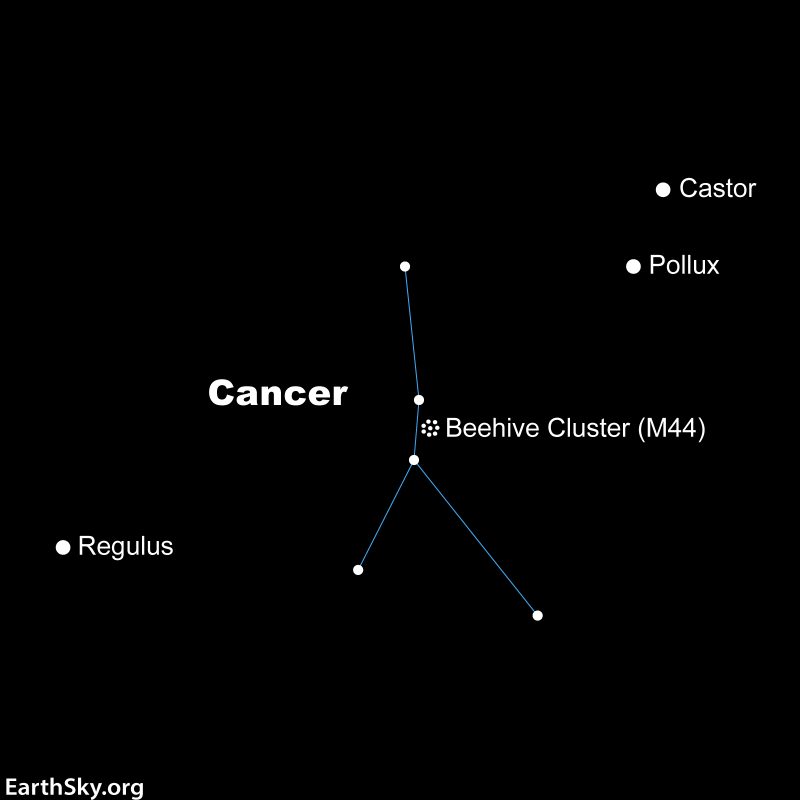
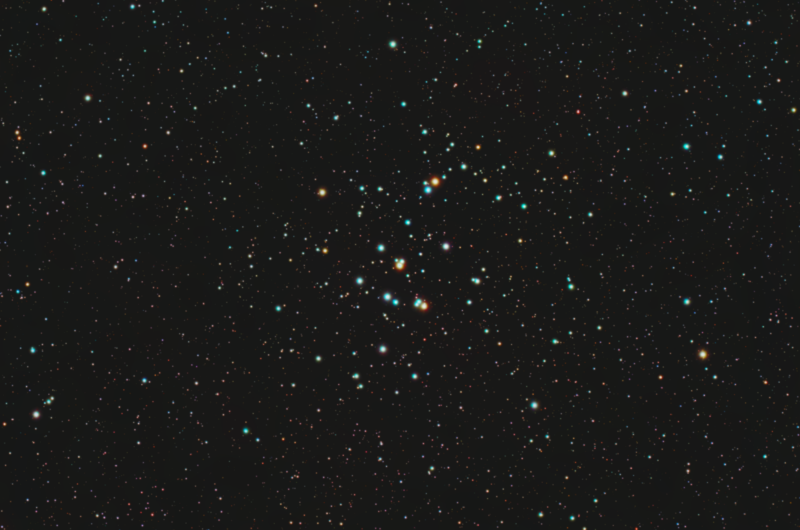
Bottom line: Open clusters are loosely bound gatherings of stars that may be so young that the nebulae they were born in is still visible. The Pleiades, Hyades, and the Beehive are well-known examples of open clusters.
A different kind of cluster: What’s a globular cluster?
The post Open star clusters are loose groups of stars first appeared on EarthSky.
from EarthSky https://ift.tt/2P4cERf

Open star clusters
Open star clusters are young, loosely bound gatherings of stars. The stars in these clusters were born together. They’re still sometimes moving within the nebula, or cosmic cloud, of their creation. They’re occasionally called galactic clusters. Scientists have discovered more than 1,100 open clusters around us in space. They may contain a handful of stars or thousands of stars. Most likely won’t survive more than several orbits around our galaxy’s center before being disrupted and dispersed. You can see many open star clusters with the eye alone! Or you can aim binoculars or telescopes their way …
Pleiades is a gem among open star clusters
The Pleiades cluster (M45) is a wonderful open cluster in the constellation Taurus the Bull. A favorite observing target, the Pleiades stands out to the eye alone as a fuzzy patch that resembles a tiny dipper. About six stars are visible with the unaided eye. Through binoculars, the view explodes into dozens of stars.
The Pleiades – aka the Seven Sisters – may have dimmed enough since its naming, because only six stars are now readily visible. The word Pleiades translates to Subaru in Japanese, and you might recognize the grouping of six stars from the car-maker’s logo. The stars in the Pleiades were born together about 100 million years ago. And the open cluster itself lies about 440 light-years away.
What about globular star clusters?
By the way, open star clusters are not to be confused with tightly bound globular star clusters. Globular clusters are ancient and far away, orbiting in the halo of the Milky Way. In fact, globular clusters formed about 13 billion years, when the Milky Way was forming. In contrast, open clusters are typically only millions of years old.
One of the best-known globular clusters seen from the Northern Hemisphere is the Great Cluster in Hercules (M13). It’s about 25,000 light-years away. Contrast the M13’s large distance to that of the relatively nearby Pleiades (444 light-years).
Read more: The Pleiades or 7 Sisters

Distance to open star clusters makes a difference
The distance to a star cluster will affect its appearance to us on Earth. Open star clusters are recognizable as a concentration of stars in one area of the sky. These conglomerations of light – such as the Pleiades or the Wild Duck Cluster (M11) – are obvious to telescope and binocular users. Many are obvious through binoculars when you are skimming along the Milky Way.
But what about star clusters that are closer to Earth?
Some Big Dipper stars are members of an open cluster
The familiar Big Dipper asterism is part of an open cluster. These stars are all about 80 light-years away and belong to a loosely assembled open star cluster known as the Ursa Major Moving Group. The Big Dipper is an example of a cluster that’s so close that it wasn’t immediately identifiable as a cluster. First, astronomers had to learn about the motions of stars in various parts of the sky. Then, they understood the Ursa Major Moving Group was an open cluster.
The Big Dipper, just like other open clusters, will grow apart as it ages. Alkaid and Dubhe, two stars in the Big Dipper, are not part of the Ursa Major Moving Group. Those two stars will stretch away from the rest and the dipper shape will become obscured, forming a new shape, just as many thousands of years ago the stars looked more like a kite with a long tail than its current dipper shape.

Watch how the Big Dipper changes over time
Hyades is another star cluster in Taurus
The V-shaped Hyades star cluster in the constellation Taurus the Bull is another excellent open cluster to target with the eye alone. The Hyades is so large you could not hope to capture the entire cluster within the field of view of binoculars or a telescope. Instead, binocular and telescope-users examine the cluster bit by bit.
The Hyades marks the head of Taurus the Bull. It is a large open star cluster in the shape of the letter V and is visible during northern winter (southern summer). This open star cluster is a group of 300 to 400 stars that lie about 151 light-years away from us, thus making it one of the nearest open clusters to Earth. With the unaided eye under moderately good seeing conditions, an observer should be able to see five stars that mark the two sides and juncture of the V.
The stars of Hyades
The five brightest stars in the Hyades are all red giants, but you’ll notice one shines much more brightly than the others. The brightest star in Hyades – and in the constellation Taurus – is Aldebaran. Aldebaran marks the top left side of the bull’s head. If Aldebaran is also a red giant star, why does it look so much brighter than the rest of the group? The reason is that it’s not a member of the Hyades cluster. It just happens to lie in the same line of sight. At 65 light-years distant, Aldebaran is 2 1/2 times closer than the rest of the cluster.

The busy Beehive cluster
The Beehive star cluster is another famous example of an easy-to-see open star cluster. The Beehive lies at the center of the constellation Cancer the Crab and is also known by the names M44 or Praesepe, which is Latin for manger.
At magnitude 3.7, the Beehive Cluster can be tricky to spot from a light-polluted area because of how diffuse it is; it’s spread out more than twice the size of a full moon. Using only your eyes, the open cluster will appear as a misty patch of light. Binoculars will help you focus in on a handful of stars. If you’re using a telescope, make sure to use a low-power eyepiece because the stars will spill out of your field of view.
Astronomers have found that the Beehive Cluster contains at least 1,000 stars, but only a fraction of them are visible with amateur equipment. By the way, Galileo saw 40 with his rudimentary telescope. Also, at least two planets are now known to be orbiting stars in the Beehive Cluster.
The cluster is about 730 million years old and lies approximately 577 light-years away from us. The Beehive’s age and direction of proper motion through space are similar to the Hyades cluster. This suggests that these two clusters probably had a common origin in a nebula that existed 800 million years ago.
The Beehive finder chart


Bottom line: Open clusters are loosely bound gatherings of stars that may be so young that the nebulae they were born in is still visible. The Pleiades, Hyades, and the Beehive are well-known examples of open clusters.
A different kind of cluster: What’s a globular cluster?
The post Open star clusters are loose groups of stars first appeared on EarthSky.
from EarthSky https://ift.tt/2P4cERf

Aucun commentaire:
Enregistrer un commentaire